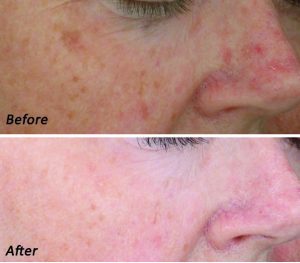J. Gregory Neily, DO – Board Certified Dermatologist, Mohs Micrographic Surgeon


Actinic keratoses, commonly called “sun spots” are actually precancerous lesions, which effect approximately 58 million Americans. They tend to be more felt than seen, feeling like rough textured dry scaly patches on the skin. If left untreated, some will develop into a form of skin cancer known as Squamous Cell Carcinoma.
Traditionally, your Dermatologist may treat Actinic Keratosis (or AK) individually. Most commonly removed with Cryosurgery, using liquid nitrogen to freeze off the lesion. A shave or surgical removal may be performed, depending on the site. But when the Actinic Keratoses are widespread, it is typically treated using a topical chemotherapy prescription for lesions both seen and unseen. In some cases, this is not easily tolerated and tends to have a longer downtime. Today there is another option for patients who are diagnosed with multiple Actinic Keratoses on the face and scalp. Photodynamic Light Therapy (PDT) sometimes referred to as “Blue Light Therapy” is a great alternative to the at-home topical chemotherapy creams.
What Is Photodynamic Light Therapy and
How Does It Work?
Photodynamic Light Therapy or PDT is a simple two-step treatment that is performed in your dermatologist office. First, a topical solution called Levulan® is applied to the precancerous areas. There is a waiting period, while the medication is absorbed in the AK’s cells,
making them extremely light sensitive. Next, the area is exposed to the blue light source, called the BLU-U Photodynamic Therapy Illuminator. The pre-
cancerous cells will react to the light and are destroyed. The exposure time varies but an average is about 17 minutes. Most cases only require one treatment but with severe sun damage, you may require a follow up session in about 4 weeks.
What Are The Advantages?
The greatest benefit of this treatment is the ability to treat a wide area at once, rather than continually treating each lesion as they appear. At the same time you are preventing new lesions from forming by removing sun damage that could eventually turn into Actinic Keratosis. It has less downtime than topical chemotherapy creams and is well tolerated. Another great advantage is that it improves the overall look of your skin. The skin’s appearance is smoother and more even toned.
What To Know Before You Choose
Blue Light Therapy
Patients receiving this treatment will be sensitive to sunlight for 48 hours afterwards. For that reason, you should avoid outdoor activities for 2 days. Many people schedule the treatment on a Friday so they can stay indoors over the weekend to avoid any exposure. Some may continue to be very sun sensitive for up to a month afterwards, so it is recommended to avoid long term sun exposure during that time. While discomfort is typically minimal, some common side effects are stinging and burning, itching, redness and swelling. As the skin heals, you may see some scaling and crusting for the duration of the treatment.
The Bottom Line
PDT is covered by most insurance and can be a very efficient way to treat widespread sun damage on your face and scalp. Dr. Neily has successfully treated many patients using BLU-U Photodynamic Therapy. If you would like to learn more about this treatment and to see if you are a candidate, please call our office at 941-493-7400 and schedule your appointment.
Visit Dr. Neily’s website at drneily.com and join their community by following them on Facebook at facebook.com/coastdermatologyfl for the latest news in skin cancer prevention, tips and technology.
J. Gregory Neily, DO
Dr. Neily is a Board Certified Dermatologist and Mohs Micrographic Surgeon and has been a practicing physician for nearly 30 years. After graduating from Florida State University he received his medical degree in from Southeastern University of Health Sciences in Miami, Florida with his dermatology residency training at Western University of Health Sciences in Los Angeles, California.
In 2002, he opened Coast Dermatology and Skin Cancer Center in Venice, Florida to offer Southwest Florida residents the highest level of professional care in an environment that is welcoming and respectful of each patient he treats. He is joined by providers, Amy Murphy, P.A.C.-MMS and Ryan Beadle, P.A.C. Coast Dermatology specializes in diseases of the skin, skin cancer and Mohs Micrographic Surgery as well as cosmetic dermatology.
Coast Dermatology & Skin Cancer Center
21550 Angela Lane, Venice, FL 34293
(941)-493-7400
 Southwest Florida's Health and Wellness Magazine Health and Wellness Articles
Southwest Florida's Health and Wellness Magazine Health and Wellness Articles

